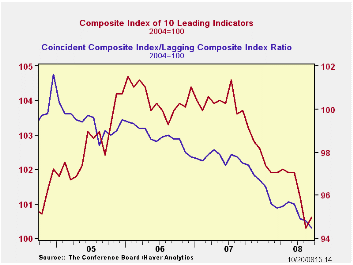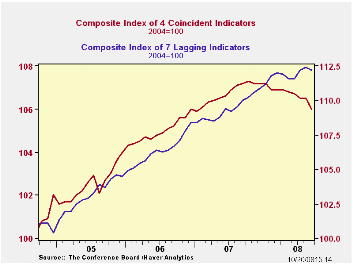 Global| Oct 20 2008
Global| Oct 20 2008Rise in U.S. Leading Indicators The Largest Since Last Year
by:Tom Moeller
|in:Economy in Brief
Summary
The composite index of leading economic indicators, reported by the Conference Board, increased 0.3% last month. The rise came after a revised August decline of 0.9% which was nearly double that reported initially. Despite the [...]

The composite index of leading economic indicators, reported by the Conference Board, increased 0.3% last month. The rise came after a revised August decline of 0.9% which was nearly double that reported initially. Despite the increase, the six-month percent change remained negative at -2.5% which was modestly improved from the low of -4.7% figure last October.
Last month's increase reflected sharp gains in the money supply, consumer expectations, the interest rate yield curve and the vendor performance components. Lower building permits, lower stock prices, higher claims for unemployment insurance and shorter weekly hours worked offset these gains with large negative contributions.
The breadth of one-month increase amongst the leaders' 10 components jumped to 60% but over a six-month period the breadth of gain amongst the components remained at its cycle low of 20%.
The leading index is based on actual reports for eight economic data series. The Conference Board initially estimates two series, orders for consumer goods and orders for capital goods.
The coincident indicators fell 0.5% after a revised no change during August. Half of the components rose and half fell for the second month, yet over six months only a quarter rose. Over the last ten years there has been an 86% correlation between the y/y changes in the coincident indicators and real GDP.
The lagging index reversed the August increase and fell 0.2% as the average duration of unemployment fell sharply. The ratio of coincident to lagging indicators (a measure of economic excess) fell further to its lowest level since 1982.Visit the Conference Board's site for coverage of leading indicator series from around the world.
This morning's testimony by Fed Chairman Ben S. Bernanke is available here.
| Business Cycle Indicators (%) | September | August | July | June, 6 Month % (AR) | 2007 | 2006 | 2005 |
|---|---|---|---|---|---|---|---|
| Leading | 0.3 | -0.9 | -0.7 | -2.5 | -0.4% | 1.3% | 2.7% |
| Coincident | -0.5 | 0.0 | -0.2 | -1.7 | 1.7% | 2.4% | 2.5% |
| Lagging | -0.2 | 0.2 | 0.5 | 0.4 | 2.9% | 3.1% | 3.1% |
Tom Moeller
AuthorMore in Author Profile »Prior to joining Haver Analytics in 2000, Mr. Moeller worked as the Economist at Chancellor Capital Management from 1985 to 1999. There, he developed comprehensive economic forecasts and interpreted economic data for equity and fixed income portfolio managers. Also at Chancellor, Mr. Moeller worked as an equity analyst and was responsible for researching and rating companies in the economically sensitive automobile and housing industries for investment in Chancellor’s equity portfolio. Prior to joining Chancellor, Mr. Moeller was an Economist at Citibank from 1979 to 1984. He also analyzed pricing behavior in the metals industry for the Council on Wage and Price Stability in Washington, D.C. In 1999, Mr. Moeller received the award for most accurate forecast from the Forecasters' Club of New York. From 1990 to 1992 he was President of the New York Association for Business Economists. Mr. Moeller earned an M.B.A. in Finance from Fordham University, where he graduated in 1987. He holds a Bachelor of Arts in Economics from George Washington University.






